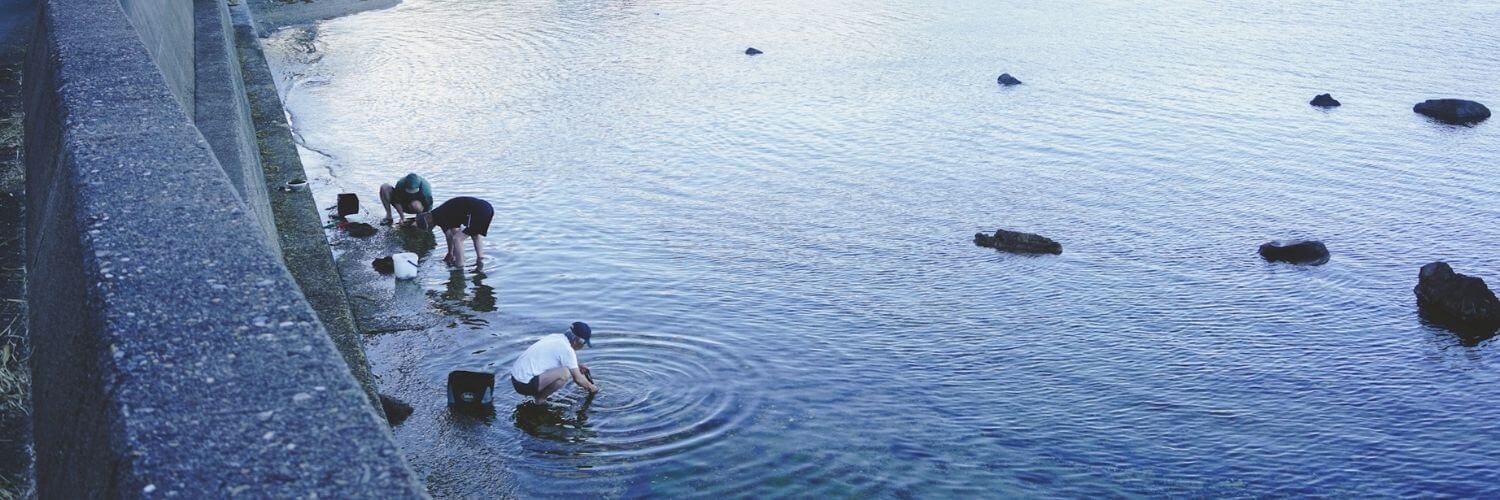
Destination, Food Travel, Shimane
Living with the Mountains, Ocean, and Fermentation Culture in Shimane – 3/3
8 minutes
SA lifestyle in Shimane consists of fresh seafood from the Japan Sea, mountains with bountiful seasonal harvests, and the rich history of fermentation culture. Take a look into life here in Shimane and what it has to offer.
I live in a small town called Omori, which is located on the coastline of central Shimane. It is surrounded by pristine mountains full of life, while also being only 10 minutes by car from the Japan Sea’s clear turquoise waters. Simultaneously, we have great sake, soy sauce, and mirin makers in Shimane, who still make the foundation of Japanese cooking using traditional methods. We may not have a convenience store at every corner, nor do we have a large shopping mall in every town. However, what we do have are what I like to consider the building blocks of life here in Shimane. The mountains, the ocean, and fermentation. These are parts of my life here in Shimane that I cannot live without, that I have learned to appreciate and continue to learn from.
In Shimane, many towns are surrounded by what the Japanese call Satoyama or undeveloped woodland near a populated area. The word sato means homeland or village, and yama is the word for mountains. As these wooded areas are mostly untouched by human hands, it is filled with nature, great for scavenging through during the different seasons. In the springtime, the mountains become full of sansai or young plant buds, which are edible and considered valuable ingredients in Japanese cuisine. One of the earliest sansai that you can forage is called fukinoto or butterbur. These are the early flower buds of the fuki plant known for their characteristic round and almost umbrella-like leaves. With their slightly earthy fragrance, they make for an excellent ingredient for tempura.




Before moving to Shimane, I never knew how these plants grew, when they were in season, where to find them, or even the different ways to cook them. They were nothing more than something you find in a plastic container during the early spring, but too overpriced to even consider buying.
In the fall season, the mountains provide a whole new variety of plants for foraging. There are akebi, a fruit that grows on vines and tastes like steamed red beans, kinmokusei, the flowers that have such floral lychee-like scent, and kuri chestnuts, that are so sweet and savory, perfect for cooking in rice.

By far, one of my most favorite plants to forage for in the mountains is sansho peppercorns or Japanese peppers during the summer. Sansho peppers are these green peppercorns with a robust, zesty fragrance, which leave a temporary tingly or almost paralyzing effect on your tongue when eaten. They are often used for various dishes like yakitori or, more famously, for unagi (Japanese eels). Excellent for cutting through the richness of fatty foods, it is a staple for Japanese cooking.
It is satisfying to find sansho in the woods since it is such a common thing to see in the supermarket. Not to mention when you find sansho in the woods, you can use all the different parts of the tree. The branches can be whittled into a pestle, the leaves can be used for garnish, and the flowers can be simmered with soy sauce into a condiment of its own. I recently started to catch unagi in the local rivers as well. Catching eel myself, filleting it, foraging for sansho, and making my unagi rice bowl was one of my most significant accomplishments here in Shimane. Having these mountains or Satoyama so close to where I live allows me to reconnect with nature and to feel the change of the seasons with newfound anticipation.


When I cannot find sansho in the mountains, though, I tend to buy them from a company called Izumo Hachizansho. They grow sansho trees in orchards that they make by the mountains, an ideal and most natural growing conditions for sansho. They also do not use any fertilizers or pesticides, which is reassuring because, with sansho, you use the whole peppercorn right down to the skin. I particularly like that they grow asakurasansho instead of budosansho. Asakurasansho tends to be a species of sansho that is less “paralyzing” and more fragrant.




While the mountains provide abundant plant life, Shimane also has the Japan Sea on its coastline. Before moving to Shimane, I lived in San Francisco, where I was always in awe of the coastline. Instead of vast beaches, the coastline is bordered by these majestic cliffs, which create a backdrop distinguished by the contrast between the rocks’ texture and the blue-gray waters. Here in Shimane, I find an environment similar to San Francisco with the turquoise waters and the rocky cliffs/islands. There is an aspect of personal preference here, I must say, but the inherent beauty of the Japan Sea seen from Shimane is a sight to behold.
The oceans here are beautiful, but the seafood in these pristine waters is something to feel in awe of as well. Before moving to Shimane, I do not think I knew the taste of real fish. Comparing the texture, flavor, the look of the fish with what I used to eat back in Tokyo, it is hard to think I was eating the same fish. Most of the fish caught here have white meat, or as we call it here, shiromizakana. Before, I only knew red snapper and flounder, but the variety in the types of fish you can buy here is impressive! We have madai (red snapper), nodoguro (black throat seaperch), aji (horse mackerel), amadai (tilefish), matoudai (john dory fish), anago (conger eel), and the list goes on.


Having access to the ocean and such fresh seafood has inspired me to learn how to fillet my fish. Learning all the different cuts on the fish and the various ways to cook them has been one of the joys of my lifestyle here in Shimane. Before I would buy premade sushi back in Tokyo, here it is mottainai (the feeling of not wasting something) not to break down a whole fish and use every part of it. I also go fishing now, as I might go in the morning to catch something for dinner or even right after work for a quick sashimi platter.


With all this seafood, there are multiple famous harbors around Shimane, one being in Hamada. Something that I did not know until recently was that Shimane is not only known for its fresh fish but also its processed seafood products as well. Products such as himono (dried fish), nerimono (fish cakes), and tsukudani (seafood simmered in soy sauce and mirin) are famous in this area. In Hamada, there is a company called Oiso that makes nori tsukudani and other seafood products for three generations.


Ojimoto-san, the company’s current owner, explained that a family business like his started because there was such an abundance of seafood being caught at the harbors. To increase the expiration date and use the less valuable catch to decrease waste, methods such as drying and simmering were used. Having both fresh kinds of seafood and good quality processed seafood is a great way to create variety in your daily life. I enjoy having fresh sashimi at night, but I prefer eating grilled himono or putting tsukudani on warm rice together with some miso soup during the mornings. With so many options, including seafood in my diet is so accessible.
The last part of my lifestyle in Shimane that I cannot live without is my soy sauce, mirin, and sake. These three ingredients can be considered the pillars of Japanese cooking and go even further Japanese culture. Each has a unique flavor to its own, but the one thing that they all have in common is that they are fermented products that use koji or more widely known as aspergillus oryzae. Fermentation using koji is probably the most crucial process in Japanese food culture, and that process is still being done using traditional methods here in Shimane. Although there are more industrial methods of making soy sauce and other fermented products, the extra steps taken for the ingredients make all the difference in the flavor.
I have fond memories relating to fermentation because I worked at a koji and miso shop back when I lived in San Francisco. It amazed me how much flavor could be unlocked from ingredients through such a simple process. Not to mention how much better the product tasted when the fermentation and the resting process were properly applied without artificial agents.


In Shimane, this fermentation tradition lives on as many soy sauce and sake makers make their products in wooden warehouses known as kura. These wooden structures act as a multigenerational home for the koji to live and grow.
When the soy sauce or sake maker decides to start making their product, they begin by growing the koji on steamed rice, wheat, or soybeans. After the koji starts to grow, it is added to some water mixture, salt depending on what you are making. That is left at room temperature for about a year as the koji starts to break down the sugars and proteins, creating umami in the process. When it is right, the slurry is strained, separating the liquid from the rest.

A couple of years ago, I had an opportunity to make my own soy sauce under a retired soy sauce maker’s instruction. I remember being amazed that this knowledge and culture were still being passed onto the next generation. The soy sauce that I made had such a fruity and bright taste that I could not believe it was the same product that the large brands make. I found the soy sauce from the leading brands had this metallic taste rather than the floral fragrance I was getting from my own soy sauce.




After realizing these differences in the richness of flavor by locally made soy sauce, and later sake and even mirin, I could not go back to buying more industrially made brands. Now I only use local brands such as Takasago Shoyu and Igeda Shoyu. I had a chance to visit Takasago Shoyu. They showed me their soy sauce making process from the wooden structures where there was a healthy colony of yeast on each beam to the vats that they would leave the slurry for over a year to age. The soy sauce’s sound bubbling as the koji fermented, the sweet and floral aroma of the aging soy sauce, and the gentle heat emitted through the fermentation process, everything felt so alive. I think that Shimane and its remaining and thriving fermentation culture shows that it is a living process. When the koji is allowed to go through its natural lifecycle in its ideal environment, it unlocks flavors and fragrances hidden in food for us.

Living in Shimane together with the mountains, the ocean, and its fermentation culture has allowed me to reconnect with food and nature. From foraging in the mountains, fishing by the sea, to fermenting my own ingredients, everything has a process and a story. Experiencing this on my own is one of the joys of living here, and being able to buy products like this casually is another one. Knowing that there are always some local and accessible alternatives made with care makes Shimane living that much better. In this way, sometimes being a little off the map and hidden amid nature can be the right lifestyle choice!
